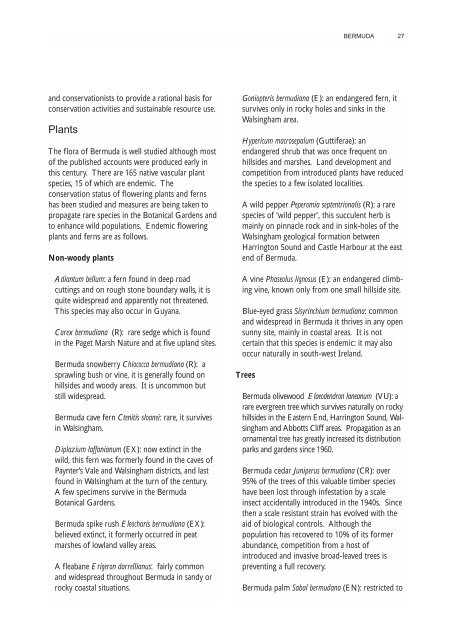Biodiversity: the UK Overseas Territories - WIDECAST
Biodiversity: the UK Overseas Territories - WIDECAST
Biodiversity: the UK Overseas Territories - WIDECAST
You also want an ePaper? Increase the reach of your titles
YUMPU automatically turns print PDFs into web optimized ePapers that Google loves.
BERMUDA<br />
27<br />
and conservationists to provide a rational basis for<br />
conservation activities and sustainable resource use.<br />
Plants<br />
The flora of Bermuda is well studied although most<br />
of <strong>the</strong> published accounts were produced early in<br />
this century. There are 165 native vascular plant<br />
species, 15 of which are endemic. The<br />
conservation status of flowering plants and ferns<br />
has been studied and measures are being taken to<br />
propagate rare species in <strong>the</strong> Botanical Gardens and<br />
to enhance wild populations. Endemic flowering<br />
plants and ferns are as follows.<br />
Non-woody plants<br />
Adiantum bellum: a fern found in deep road<br />
cuttings and on rough stone boundary walls, it is<br />
quite widespread and apparently not threatened.<br />
This species may also occur in Guyana.<br />
Carex bermudiana (R): rare sedge which is found<br />
in <strong>the</strong> Paget Marsh Nature and at five upland sites.<br />
Bermuda snowberry Chiococca bermudiana (R): a<br />
sprawling bush or vine, it is generally found on<br />
hillsides and woody areas. It is uncommon but<br />
still widespread.<br />
Bermuda cave fern Ctenitis sloanei: rare, it survives<br />
in Walsingham.<br />
Diplazium laffanianum (EX): now extinct in <strong>the</strong><br />
wild, this fern was formerly found in <strong>the</strong> caves of<br />
Paynter’s Vale and Walsingham districts, and last<br />
found in Walsingham at <strong>the</strong> turn of <strong>the</strong> century.<br />
A few specimens survive in <strong>the</strong> Bermuda<br />
Botanical Gardens.<br />
Bermuda spike rush Eleocharis bermudiana (EX):<br />
believed extinct, it formerly occurred in peat<br />
marshes of lowland valley areas.<br />
A fleabane Erigeron darrellianus: fairly common<br />
and widespread throughout Bermuda in sandy or<br />
rocky coastal situations.<br />
Goniopteris bermudiana (E): an endangered fern, it<br />
survives only in rocky holes and sinks in <strong>the</strong><br />
Walsingham area.<br />
Hypericum macrosepalum (Guttiferae): an<br />
endangered shrub that was once frequent on<br />
hillsides and marshes. Land development and<br />
competition from introduced plants have reduced<br />
<strong>the</strong> species to a few isolated localities.<br />
A wild pepper Peperomia septentrionalis (R): a rare<br />
species of ‘wild pepper’, this succulent herb is<br />
mainly on pinnacle rock and in sink-holes of <strong>the</strong><br />
Walsingham geological formation between<br />
Harrington Sound and Castle Harbour at <strong>the</strong> east<br />
end of Bermuda.<br />
A vine Phaseolus lignosus (E): an endangered climbing<br />
vine, known only from one small hillside site.<br />
Blue-eyed grass Sisyrinchium bermudiana: common<br />
and widespread in Bermuda it thrives in any open<br />
sunny site, mainly in coastal areas. It is not<br />
certain that this species is endemic: it may also<br />
occur naturally in south-west Ireland.<br />
Trees<br />
Bermuda olivewood Elaeodendron laneanum (VU): a<br />
rare evergreen tree which survives naturally on rocky<br />
hillsides in <strong>the</strong> Eastern End, Harrington Sound, Walsingham<br />
and Abbotts Cliff areas. Propagation as an<br />
ornamental tree has greatly increased its distribution<br />
parks and gardens since 1960.<br />
Bermuda cedar Juniperus bermudiana (CR): over<br />
95% of <strong>the</strong> trees of this valuable timber species<br />
have been lost through infestation by a scale<br />
insect accidentally introduced in <strong>the</strong> 1940s. Since<br />
<strong>the</strong>n a scale resistant strain has evolved with <strong>the</strong><br />
aid of biological controls. Although <strong>the</strong><br />
population has recovered to 10% of its former<br />
abundance, competition from a host of<br />
introduced and invasive broad-leaved trees is<br />
preventing a full recovery.<br />
Bermuda palm Sabal bermudana (EN): restricted to
















